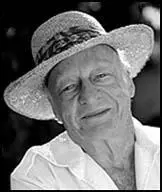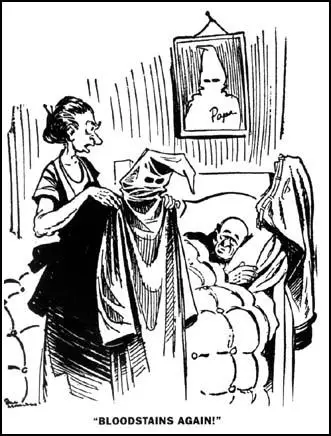Stetson Kennedy

Stetson Kennedy was born in Jacksonville, Florida, in 1916. After graduating from the University of Florida he joined the Federal Writers Project (1935-39). While working on the project Kennedy was deeply influenced by the book, You Have Seen Their Faces (1937), a documentary account of impoverished living conditions in the South, that had been produced by the novelist, Erskine Caldwell, and the photographer, Margaret Bourke-White.
Kennedy became a newspaper reporter and wrote investigative articles for the New York Post. His first book, Palmetto County, was published in 1942.
A member of the NAACP, Kennedy was a strong opponent of racism and in 1950 "campaigned for the U.S. Senate from Florida as an independent 'colour-blind' candidate on a platform calling for a 'live and let live' foreign policy and total equality at home."
As an investigative journalist, Kennedy joined the Ku Klux Klan. Articles about his activities appeared in the New York Post. He also supplied information of its illegal activities to the Federal Bureau of Investigation (FBI) and the House of Un-American Activities Committee (HUAC) but both organizations showed little interest in what he found. Kennedy also wrote several books about racism such as Southern Exposure (1946), Forced Labor in the United States (1953), I Rode With the Klan (1954), Jim Crow Guide to the U.S.A (1959) and The Klan Unmasked (1990).

Kennedy's last book, After Appomattox: How the South Won the War (1995), explains how the Old South converted military defeat into political and social victory. Kennedy was also featured in Coming of Age (1995) by Studs Terkel. In 2001 Stetson Kennedy was given the Benjamin Spock Peacemaker of the Year Award.
Stetson Kennedy died on 27th August, 2011, at Baptist Medical Center South in Jacksonville, Florida.
Primary Sources
(1) Stetson Kennedy, I Rode With the Klan (1954)
In delving into both old and new outrages perpetrated by the Klan, I was soon struck by one all-important fact - almost all the things written on the subject were editorials, not exposes. The writers were against the Klan, all right, but they had precious few inside facts about it. Their punches consequently lacked the dynamite I knew it would take to score a knockout blow against the Klan.
The need, obviously, was not just for more words, but legal evidence on the Klan's inside machinations - evidence which could be taken into court and used to put the Klan's leaders behind bars where they belonged. To get such evidence - just as obviously - somebody would have to go under a Klan robe and turn the hooded order's dirty linen inside out for all the world to see.
(2) After joining the Ku Klux Klan, Stetson Kennedy was able to informally interview Cliff Carter, the Night Hawk of the Klan.
The Kloran of the Klan defines a Klavalier as the soldier of the Klan. We take our name from the cavalier - a courtly, polite, cultured and very courageous and skillful soldier of the seventeenth and eighteenth centuries.
As the Military Department of the Invisible Empire, we Klavaliers also serve as the secret police of the KKK and are entrusted with carrying out all "direct-line" activity. We are a militant army, serving our country in peacetime as the U.S. Army does in wartime! Our country was founded by a white Protestant nation, and we intend to maintain it as such! Any attempt to influence its affairs by inferior racial minorities or persons owing allegiance to foreign prelates or potentates will not be tolerated!
All hyphenated groups - whether they be Negro-Americans, Jewish-Americans, Catholic-Americans, Italian-Americans or whatever must become American-Americans, or leave the country! The Ku Klux Klan is an American-American organization. As the Army of the Klan we Klavaliers are dedicated to saving America for Americans!
(3) Stetson Kennedy was present when an African American cab-driver was murdered by the Ku Klux Klan for carrying a white woman in his cab.
The Negro man watched out of the corner of his eye. But the fear he must have felt upon discovering he was in the hands of the Klan did not show in his face.
We turned off the highway and on to a clay road that threaded off through the pine flatwoods. When we came to a clump of hardwood trees at the head of a branch, Randal stopped the cab. Reaching over and opening the door, he gave the Negro a shove that sent him sprawling face first on to the ground. Almost before I knew what was happening, both carloads of Klavaliers had swarmed around him, and were kicking at his prostrated form amid a torrent of profanity. The Negro groaned and doubled over to protect his groin, but he made no plea for mercy.
Randal, meanwhile, was standing on the sidelines, calmly putting on his robe. That done, he stepped up, and the kicking subsided. "You'd better say your prayers, nigger!" he said. "Your time has come."
(4) In his book, I Rode With the Klan, Stetson Kennedy described the election of Gene Talmadge, the Governor of Georgia.
Talmadge was elected Governor of Georgia after a whirlwind campaign of Klan terror aimed at keeping Negroes from going to the polls. On the eve of the election, fiery crosses had flamed on court-house lawns all over Georgia. Notices signed "KKK" were tacked on to Negro churches, warning, "The first nigger who votes in Georgia will be a dead one." Other warnings were sent to Negroes through the U.S. mails, and others were dropped from airplanes over Negro neighbourhoods.
On election day, thousands of Negroes awoke to find miniature coffins on their doorsteps. My union friend Charlie Pike led his locals, white and Negro alike, to march to the polls and vote as a body. And though many thousands of Negroes defied the Klan and voted for the first time, in the end the forces of hate carried the day, Talmadge was elected, and the liberal supported by Governor Arnall was defeated.
(5) In his book, I Rode With the Klan, Stetson Kennedy wrote about the murder of his friend, Harry T. Moore, on 25th December, 1951.
Terrorists planted a bomb under the bedroom of Mr. and Mrs. Harry T. Moore, Negro residents of Mims, a small town north of Miami. Moore was killed instantly. His wife died after a week of suffering. Even though Mrs. Moore said she had a "good idea" who planted the bomb, neither the local police nor Governor Warren's special investigator Elliott nor the F.B.I. bothered to take any statement from her before she died.
Moore was a two-fisted saintly fighter for democracy, who throughout his life was in the forefront of the struggle of his people for a greater measure of justice. at the time of his death he was not only state secretary of the N.A.A.C.P. but also leader of the Progressive Voters League of Florida.
(6) Working undercover as a member of the Ku Klux Klan, Stetson Kennedy discovered the organization switched its support from the Democratic Party to the Republican Party when Dwight Eisenhower was selected as its presidential candidate in 1952.
It was Eisenhower's record as an enforcer of racial segregation in the U.S. armed forces, that opened up the possibility of swinging the traditionally Democratic South into the Republican camp. "My policy for handling coloured troops will be absolute equalitative treatment, but there will be segregation where facilities are afforded," Eisenhower had said in 1942 - and the Klan proceeded to make much of this fact.
On July 16th of that same year, a directive bearing Eisenhower's signature went out to the red Cross clubs in London, ordering that, "Care should be taken so that men of two races are not needlessly intermingled in the same dormitory or at the same tables in the dinning-halls."
Finally, when in campaigning for the presidency Eisenhower announced his opposition to civil rights legislation by Congress, the Klan took off the wraps and went all out for Ike. On election day, more Negroes than ever before in American history defied the Klan terror and marched to the polls - but nevertheless at least five million were kept from voting. The hate propaganda did its work, and Kludd Shuler's prediction that five Southern states would go for Eisenhower came true.
(7) Stetson Kennedy, I Rode With the Klan (1954)
Another signal for the Ku Klux Klan ideology is represented by the McCarran Immigration Act. sponsored by Republican Senator Pat McCarron - who is also the author of the U.S.A.'s concentration camplaw - and Republican Congressman Francis Walter, the new law bars coloured races almost entirely, while favouring immigration by north Europeans. Instead of working for repeal of this racist law, Eisenhower has asked for special quotas to let in migrants from eastern Europe, most of whom are diehard German Nazis.

